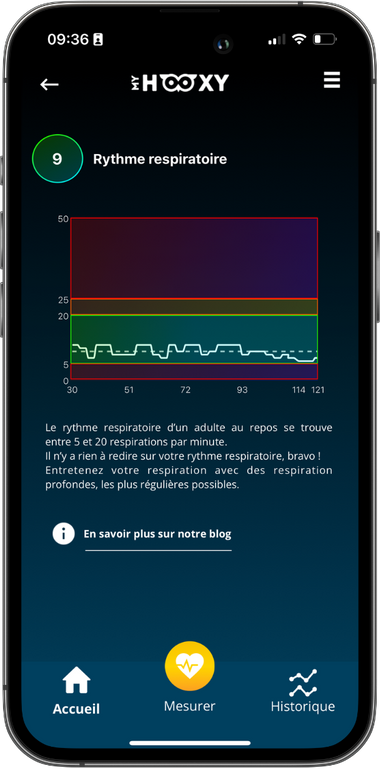
What do I need to know about respiratory frequency?
What is respiratory rate?
Respiratory rate is the number of breaths per minute. The normal respiratory rate of a healthy adult at rest is 12 to 20 breaths per minute. A respiratory rate of less than 12 or more than 25 breaths per minute at rest is considered abnormal. However, during a controlled breathing exercise, the respiratory rate can be as low as 5 breaths per minute.
The normal respiratory rate for children is higher and depends on the child’s age.

Comment mesurer la fréquence respiratoire ?
Votre fréquence respiratoire est généralement mesurée lorsque vous êtes au repos et consiste simplement à compter le nombre de respirations que vous prenez en une minute.
Dans les cliniques et les hôpitaux, la fréquence respiratoire est mesurée à l’aide d’un appareil qui évalue la quantité de dioxyde de carbone expiré. Au cours des essais cliniques, l’utilisation de ceintures évaluant les mouvements de la poitrine est couramment utilisée pour mesurer la fréquence respiratoire.
Why is it important?
Since breathing is a process involving the brain, brain stem, respiratory muscles, lungs, airways and blood vessels, respiratory rate is an important vital sign.
The most common factors that can affect measured respiratory rate are
– The emotional state
– Physical condition
– Internal temperature
– Your state of health (including any health problems)
People suffering from certain health problems experience changes in their respiratory rate. In particular, we know that an elevated respiratory rate is a strong and specific warning sign of serious problems that may require unscheduled admission to an intensive care unit..
What causes a slowdown in respiratory rate?
-
L’alcool est un dépresseur qui entraîne un relâchement des muscles (y compris ceux impliqués dans la respiration).
-
Les opioïdes et certains médicaments ont pour effet secondaire la dépression respiratoire, qui entraîne une respiration lente et inefficace, et fait chuter le taux d’oxygène dans le sang à des niveaux dangereusement bas.
-
Un accident ou une lésion cérébrale peut présenter de nombreux symptômes, notamment une respiration lente et peu fréquente.
-
L’apnée du sommeil est un trouble au cours duquel la personne ralentit et arrête de respirer pendant de courtes périodes pendant son sommeil.
-
Problèmes métaboliques : une thyroïde sous-active (hypothyroïdie) entraîne un ralentissement du système métabolique, ce qui se traduit par un ralentissement du rythme cardiaque et du rythme respiratoire (entre autres symptômes).
-
Allergic reactions, when the body goes into shock, cause a number of symptoms, including narrowing of the airways. By breathing more rapidly, the body tries to obtain sufficient oxygen despite the narrowing.
-
Asthma is another condition where the airways narrow, making breathing difficult. Asthma patients breathe more rapidly during acute attacks in an attempt to obtain sufficient oxygen.
-
Anxiety triggers the fight-or-flight mechanism, which activates rapid breathing (hyperventilation) and an accelerated heart rate.
-
Lung conditions (such as chronic obstructive pulmonary disease) mean that damage to the lungs or airways inside the lungs means that exhaled air comes out more slowly than normal, often leaving a large amount of air inside the lungs, so the body has to breathe faster to compensate for the lower amount of oxygen with each breath.
-
A fever occurs when the body’s internal temperature has risen, which also increases the body’s metabolic rate. This means that the body’s cells also need more oxygen, which is supplied by faster breathing.
-
Dehydration has many effects on the body, not least an increase in internal body temperature. As in the case of a fever, the heart rate accelerates and the respiratory rate also increases, in order to supply the greater quantity of oxygen required in these conditions.
-
Disease (lower respiratory tract infections such as COVID or pneumonia). In the case of COVID, the virus infects the air sacs or alveoli, i.e. the blood-lung interface that allows oxygen to pass from the lungs to the blood and carbon dioxide to pass from the blood to the lungs (to be exhaled). When the number of healthy alveoli is reduced, each breath is less efficient at transferring oxygen and carbon dioxide, meaning that more breaths are needed to maintain oxygen levels in the blood.
-
Metabolic problems an overactive thyroid (hyperthyroidism) accelerates the metabolic system, resulting in a faster heart rate and respiratory rate (among other symptoms). Les stimulants (café, certains médicaments) sont en fait des stimulants respiratoires qui ciblent le centre respiratoire du cerveau.
-
Stroke or brain damage can present many symptoms, including rapid, shallow breathing.Des troubles cardiaques (tels que l’insuffisance cardiaque congestive), qui se produisent lorsque le cœur ne parvient pas à pomper suffisamment de sang riche en oxygène vers les muscles et les organes, de sorte que l’organisme réagit en respirant rapidement et fortement pour augmenter la quantité d’oxygène dans le sang.
Should I monitor my own respiratory rate?
Yes, it’s a good idea to know your normal breathing frequency. Regular monitoring allows you to detect any changes as soon as they appear, and to seek medical advice.
And don’t forget :
With detection and treatment, most heart problems can be stabilized or even reversed.